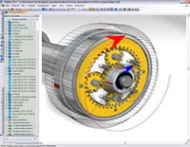Home > CAD Service > Simulation Analysis

Simulation Analysis

In simulation analysis, we create a mathematical model of a system or process, usually on a computer, and we explore the behavior of the model by changing key values (inputs) of the system and observing how the system responds each time. this is called running a simulation. A simulation consists of many -- often thousands of -- trials. Each trial is an experiment where we supply numerical values for input variables, evaluate the model to compute numerical values for outcomes of interest, and collect these values for later analysis.
-
Assembly Simulation: Study the interactions of assembly components on-screen, before incurring the costs of physical prototypes. Simulate static or dynamic loads to evaluate your design’s performance under stress, strain, and displacement.Apply a wide variety of physics-based models to simulate real-world operating conditions for your design. Check for colliding parts. Output numerical and graphic data of the results, as well as animations of your tests.
-
Simulate Vibrations: Predict and control vibrations or dynamic responses in your products with a choice of integrated design studies, including Transient study, Harmonic Response study, and Random Response study.Virtually apply forces, pressure, gravity, and centrifugal forces to your designs to determine maximum loads before buckling. Study the effects of various materials as well as isotopic and orthotropic factors.Thermal analysis capabilities enable you to easily study heat effects on your designs. Simulate thermal boundary conditions, fluid flow, thermal-structural interactions, and radiation effects in high-temperature applications.
-
Simulate Drop Test or Impact: The drop test simulation had been adopted by industries for years, it is still a challenging problem to replace the physical test, which requires the drop test simulation to supply reliable results and sufficient information. Another challenging requirement is to detect the failure inside small components during the product level drop test simulation. The finite element method (FEM) is used to simulate drop test numerically, while the attention is paid to the methodology for analyzing the reliability of electronic devices under drop impact. Some important issues, such as control of the simulation and material model. Examples are presented to illustrate the application of FEM on virtual product development simulations.
-
Simulate Welded Structures: Ensure your welded structures perform at peak operating conditions. Apply pressure, forces, and bearing loads. Then use visualization tools like section plots, ISO clipping, and animation to review the response.
-
Product Failure Prediction: Save the time and cost of prototyping, while creating safer, more durable products. Predict structural failure thresholds due to yielding, overheating, buckling, and fatigue. Determine the best design option by comparing strengths, life, cost, and weight. Perform all comparisons and design modifications within the SolidWorks environment.
-
Simulate Heating or Cooling : Save time and cost by reducing the number of physical tests. Define drop height, surface, and orientation. Perform realistic collision simulation between parts or assemblies.
Contact us for more simulation analysis services
Service Categories
Contact Us
Address: 999 NingQiao Road Jinqiao Export Processing Zone,Pudong,Shanghai P.R.C.
Tel: +86-015618333663
Skype: twcad
Yahoo Im: twcad2012
Gtalk: twcad
Email: twcad@sohu.com
